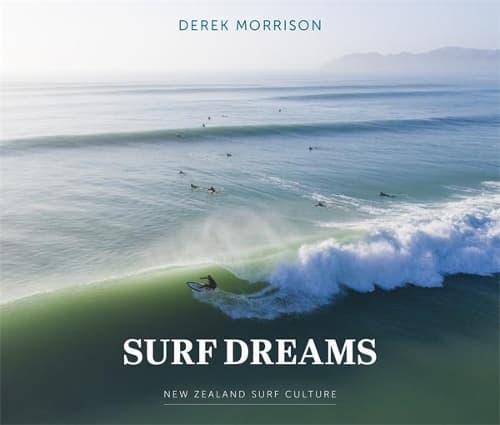Review: Surf Dreams
Reviewed by Jennifer McIndoe
It’s fair to say I’ve visited a few surf breaks in my time, so I checked out Derek Morrison’s new book Surf Dreams with interest. Morrison has travelled the length of New Zealand stopping at 15 major surfing communities from Ahipara in the north to Riverton in the south. Using a combination of photographs and conversations with surf-loving locals from old salts to grommets, he documents the surfing culture that is particular to Aotearoa New Zealand.
Morrison differs from most surfers I know in that he grew up on a dairy farm in Putaruru and didn’t discover surfing until he went to Massey University to study veterinary science; it means he was never part of the “grommet scene” (in surfing parlance, a grommet is a young participant in what’s regarded as an extreme sport). Photography was the other passion he discovered, and his images featured in New Zealand Surfing Magazine where he eventually became editor.
Being an amateur photographer, I was particularly interested in the photos which range from action shots through to beautiful landscapes and portraits of local characters. They capture New Zealand beach life well and it’s fair to say I would be stoked if I had taken some of these.
The book starts with a foreword by legendary New Zealand surfer and shaper Roger Hall - who lives and surfs in my corner of the country with his dog Taz - and thoughtfully ends with a glossary of surf terminology along with a timeline of surfboard evolution.
In between, the book covers the introduction of surfing in New Zealand, the big names who established surfing styles and board technologies, along with the lesser-known individuals who were also part of the story. There are plenty of competitive surfers in there; some names I was familiar with and others not.
Paige Hareb talks about the reality of being a Kiwi surfer on the world stage, living on a shoestring while international stars travel with a whole crew. Jai Earnslaw, from Greymouth, trained on the Gold Coast with Joel Parkinson and Mick Fanning, but his sponsor wanted him back in New Zealand. Morrison also meets folks who own surf stores, make boards and run surf schools.
In the North Island, he travels to surfing meccas such as Whangamata, Raglan, Gisborne, Mount Maunganui and Taranaki. The recent resurgence of interest in surfing, causing overcrowding on breaks when the conditions are good, is a common theme from locals; townies not observing the surfing code and stand-up paddleboarders stealing waves. Another issue is the increase in property prices as prime land is bought for top dollar which drives out the long-term locals, in particular the kids of families who have lived there for generations.
In the South Island, there’s Kaikoura where the coastline changed forever after the 2016 earthquake giving rise to phenomenon like Hope Springs, with soda water bubbles in the ocean. At Sumner, there’s New Zealand-made wetsuits company Seventh Wave; in Dunedin, there are locals battling it out with the uni students and right down the bottom, there is wildlife to share the waves with (I think I’d just stick with photography there).
In this year of restricted international travel, this book may make you realise it’s time to visit somewhere new in New Zealand. I’ve already driven Punakaiki to Haast this winter with the husband muttering about the surf conditions along the way and the lack of surfers to be seen. Turns out people do surf there but it’s cold and rocky and Westport sounds gentler. Maybe I’ll try Ahipara next - I could stay at a luxury hut overlooking Shipwreck Bay and try for some great sunset photos while the family surfs.
I reckon I’ll drop this book in the husband’s Christmas stocking; I think it will be well received.
Reviewed by Jennifer McIndoe
